Highlights
- Across 13 site-years, delaying cereal rye termination until planting did not affect soybean yield. Delaying termination two weeks after planting, however, negatively impacted soybean yield in one year out of two.
- Planting soybeans “green” into cereal rye resulted in over 2.5x more aboveground biomass and reduced weed abundance
- Soybean stand reduction can result from planting green into rye – consider slightly higher soybean seeding rates when planting into a thick cover crop
In the news: To plant green or to plant brown? Rye cover crop termination timing before soybeans (Field Crop News)
Purpose
The overall objective of this project was to determine methods to manage a cereal rye cover crop to achieve multiple benefits, while minimizing any negative effects on crop yield. The project had two components: 1) to evaluate spring rye termination timing and its effects on nutrient uptake, weed abundance and soybean development and yield, and 2) to evaluate a cover crop-based organic (or herbicide-free) no-till soybean production system using a roller crimper to terminate cereal rye. This report includes information on the first component. For information on the second component, refer to “Maximizing cereal rye cover crop management for multiple benefits: Cover crop-based organic no-till soybean production”.
Cereal rye is a relatively inexpensive cover crop that provides a variety of benefits including erosion reduction, weed competition, nitrogen scavenging and soil organic matter building. It is very winter hardy and in many cases is the only cover crop option to seed after grain corn or soybeans in Ontario.
The potential benefits of cereal rye can be maximized by allowing longer growth in spring. By delaying termination of cereal rye to the time of soybean planting, biomass can be greatly increased. In wet springs, actively growing rye may also help dry soil by transpiring moisture. There is, however, some risk associated with delayed rye termination. Greater rye biomass can delay soil warming, dry out soil excessively in dry springs, affect the crop stand and slow early season soybean development.
In these trials, replicated and randomized strips were used to evaluate the impact of different termination timings on cereal rye biomass, soil nitrogen, weed abundance, soil moisture and temperature, as well as soybean population and yield.
Methods
Eight on-farm and three research stations trials were completed in 2019 and 2020. They have been compiled with data from four additional on-farm trials conducted in 2017 and 2018. There were two main treatments: cereal rye or no cereal rye cover crop. Within the cover crop treatment, there were two sub-treatments: early termination of rye (approximately two weeks before soybean planting) and late termination (day of planting, also referred to as “Plant Green”). Treatments were replicated 2-6 times depending on the site and randomized throughout the plot area. Background site information is provided in Table 1.
At the Winchester Research Station site, additional treatments were evaluated in both 2019 and 2020:
- Two cereal rye fall seeding dates were compared:
- Early (S1)
- Late (S2)
- Four spring termination timings:
- Sprayed two weeks before planting (2019 & 2020) (T1)
- Sprayed one week before (2019) or at planting (2020) (T2)
- Sprayed at planting (2019) or one-week (2020) post-planting (T3)
- Sprayed one week (2019) or two weeks (2020) post-planting (T4)
Only data for two termination timings (termination two weeks before planting and at planting) averaged across seeding timing treatments are presented throughout the report for simplicity. Yields for all treatment combinations, however, are provided at the end of the report.
At the Morrisburg 2020 site, termination after soybean planting was evaluated. Rye was terminated approximately one week and 2.5 weeks after soybean planting (which occurred on May 14th). The no-rye control treatment only had one replicate. Yield data is presented separately from the other sites.
Table 1. Site descriptions and cereal rye seeding details of trial locations
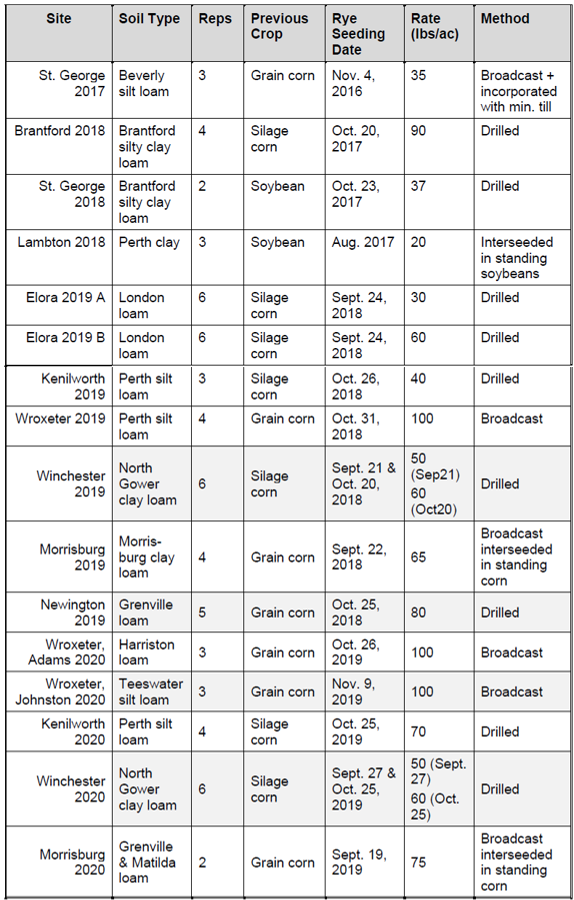
No tillage was performed at any of the sites except for St. George 2017, where minimum tillage was done on grain corn residue in fall of 2016, and Elora 2019, where a culti-packer was used to prior to rye seeding. A combination of herbicide (glyphosate)and roller crimper was used to terminate rye at the Elora 2019 site. Herbicides were applied as appropriate for weed control at all sites, except at the Elora 2019 A and B sites, which only received a single herbicide application in the late termination treatment.
Table 2 describes soybean varieties grown, seed treatments and herbicides used.
Cereal rye biomass was sampled approximately at the time of termination from multiple locations within each strip and samples were oven-dried to 0% moisture and weighed. Sub-samples of dry biomass were submitted for nutrient analysis.
Table 2. Soybean variety, seed treatment and burndown herbicide for each site
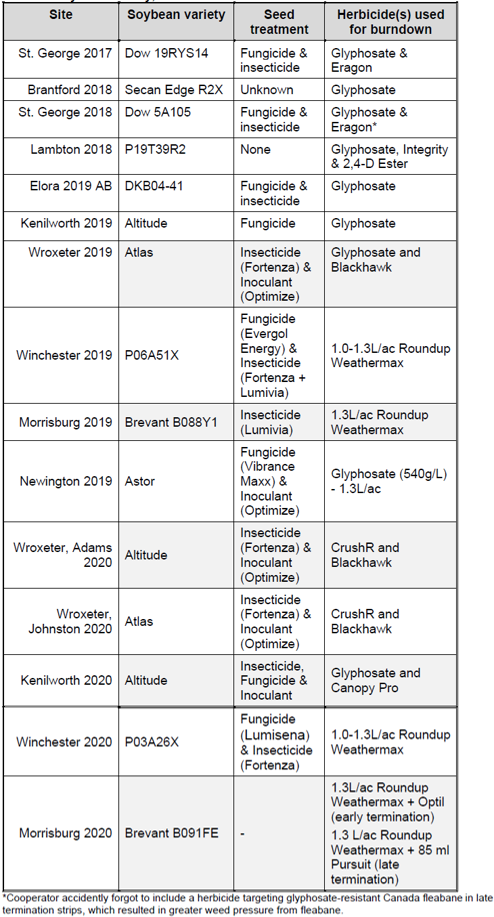
Soil samples for soil nitrate (NO3-) were taken from a depth of 0-12 inches within each treatment. Samples for early terminated and late terminated strips were taken on the same date at each site (approximately the date of soybean planting) and kept cool until delivery to soil test laboratory.
Average plant stand values were calculated from counts at multiple locations in each strip at each site.
Yield was determined by weigh wagon, well-calibrated yield monitor data or by combine scale at research station plots. Values were adjusted to 13% moisture.
Weed abundance (e.g. number of weeds within a square metre) at the beginning of the critical weed-free period in soybean (V1) was measured at the Elora and Winchester Research Station (University of Guelph) as well as on-farm trial sites in Morrisburg, Wroxeter and Kenilworth, Ontario.
Statistical analysis was performed on yield data. Different letters indicate a significant difference (P < 0.05).
Results
Rye growth accelerates in May
Across ten sites, rye biomass increased on average by 2.7-times when terminated at time of soybean planting compared to ~2 weeks prior (Table 3). Extra biomass contributes to soil organic matter, soil structure and provides a longer-lasting mulch.
Table 3. Average rye biomass (dry) at early versus late termination timings
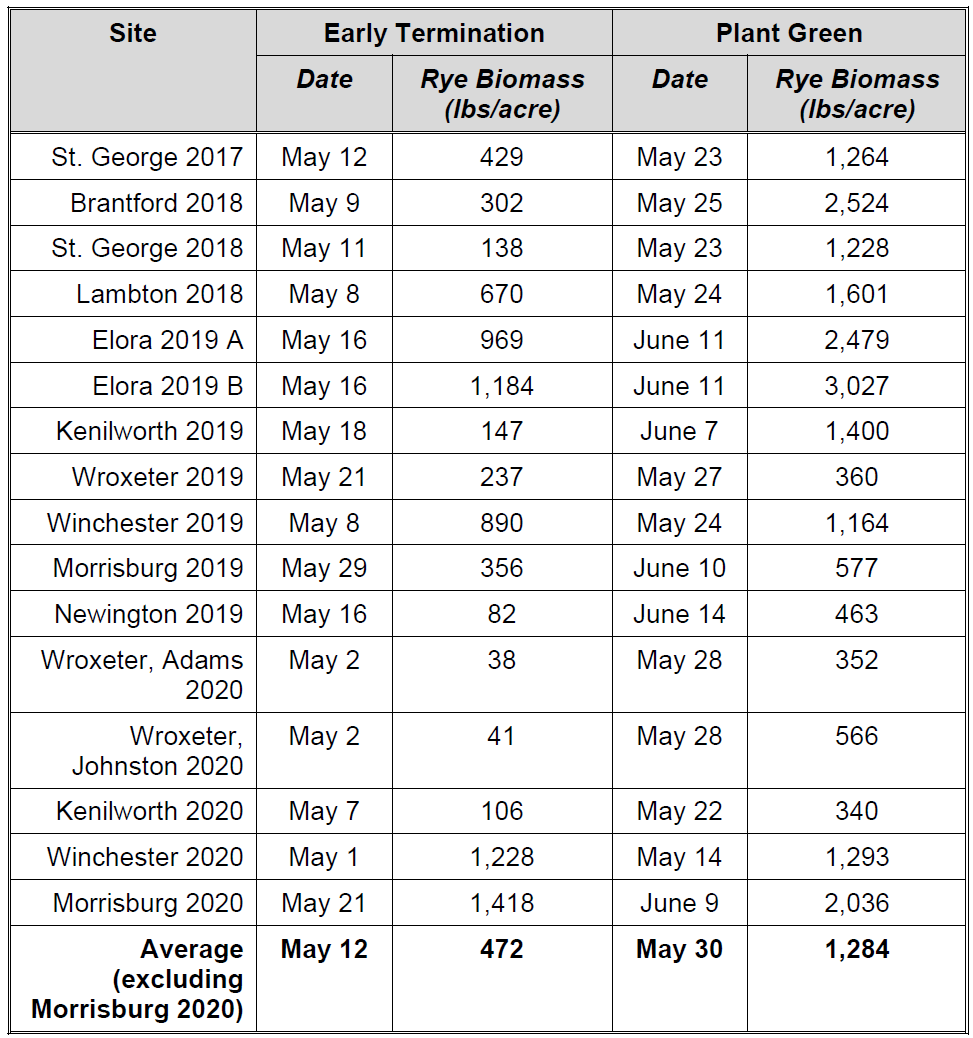
Figure 1. Cereal rye strips at the Kenilworth 2019 site shortly after early termination (May 18; left) and just prior to “planting green” (June 7; right)
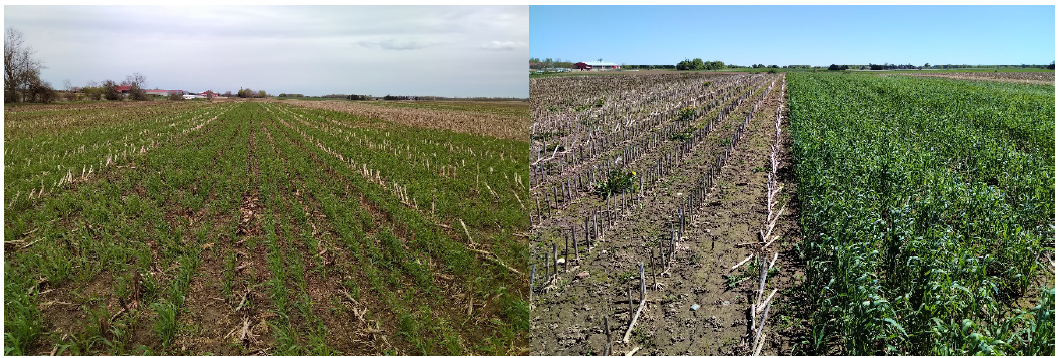
Nitrogen effects
Delayed termination of rye resulted in slightly reduced soil nitrate levels at the time of planting. Across 14 site-years, early termination strips averaged 11.0 ppm (min. 8.4 ppm, max. 18.8 ppm), while plant green strips had an average concentration of 8.3 ppm (min. 6.1 ppm, max. 13.9 ppm). Extra nitrogen uptake translated into differences in the amount of nitrogen scavenged in aboveground rye biomass. Across the same sites, cereal rye took up an average of 28.1 lbs/acre when terminated late and only 18.1 lbs/acre when killed early (Figure 2).
Nitrogen taken up by rye is released slowly over the season and is less likely to be lost to the environment through denitrification or leaching. In cases of high N uptake, it may also play a role in weed suppression by reducing soil availability. Since soybeans fix their own nitrogen, moderate uptake is unlikely to negatively affect the crop.
Figure 2. Nitrogen scavenged by cereal rye cover crop averaged across 14 sites (bars represent standard error).
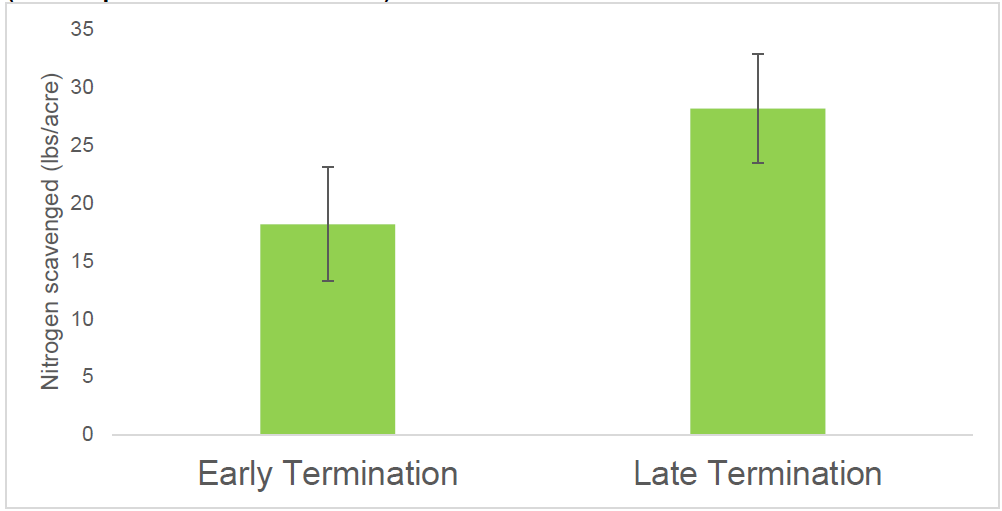
Planting green can impact soybean stand and crop development
Delaying termination of rye does not come without some risk. Soybeans stands were reduced at some sites (Table 4). It’s particularly important to plant into moisture and ensure that the seed trench is closed. Also, if conditions are very dry leading up to planting, terminating rye early can avoid even drier soil.
There was no difference in soybean development between no rye strips and early termination strips. Soybeans in late-terminated, higher biomass rye, however, tended to have delayed development. At the Brantford, Lambton and Elora sites, plants were consistently one growth stage behind in the “plant green” plots relative to the early termination strips (Figure 3). Soybeans are adaptable, to a point, to reduced stands and moderate delays in development. At the Brantford 2018 site, for example, despite delayed early season growth, soybeans planted green into rye had an equal or greater number of pods per plant and seeds per pod compared to those in the early-terminated rye (Table 5).
Table 4. Soybean population, seeding rate and method
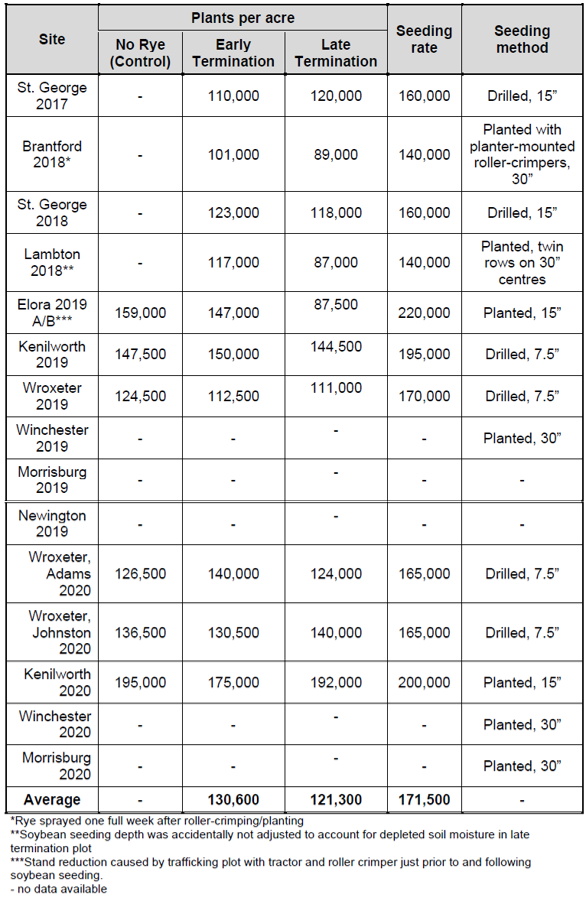
Figure 3. Soybeans at the Brantford 2018 site on June 26 (left) and the Lambton 2018 site on July 31 (right), where soybeans planted into early terminated rye were taller, greener, and one growth stage ahead.
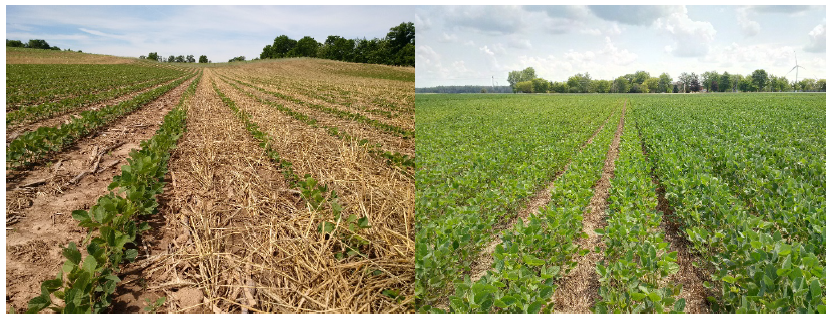
Table 5. Number of nodes and pods per plant at Brantford 2018 site observed on September 6, 2018

Soil moisture and temperature
Soil moisture was measured at 2-inch depth, mid-row, in each of the treatments at the Elora Research Station (plot B) from late April until harvest in 2019. Figure 4 shows the differences in soil moisture in spring in the lead-up to planting. During this period, soil in the rye treatments was wetter than the no-rye control. The strips with early terminated rye were intermediate in moisture content.
The difference in soil moisture was likely due to reduced evaporation from the soil underneath the rye. As the rye grew rapidly and headed out, however, it began transpiring more water, which helped dry out the soil. The residue from the early terminated rye likely contributed to slightly wetter conditions than the no rye control. In a dry spring, it is quite possible that the soil with the late terminated rye would have been drier than the no-rye soil.
Figure 4. Soil moisture at 2-inch depth in all treatments at the Elora Research Station: no rye control, early terminated and late terminated rye (mean of four replicates per treatment), May 7-June 11, 2019
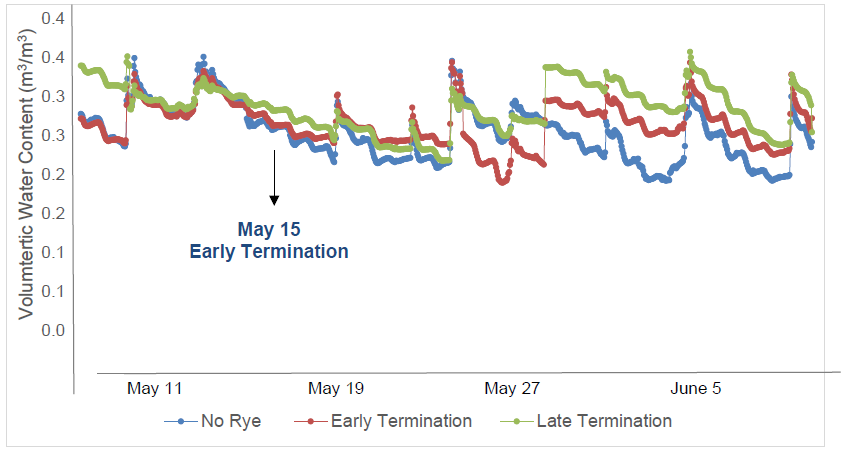
After planting (June 12), soil moisture levels remained highest under the late terminated rye (Figure 5). The rye mulch on the soil surface helped to reduce evaporation and maintain higher soil water content following rainfall events. This was important from late June to mid-July, during which time there was no rainfall at Elora. The elevated soil moisture in the late termination treatment remained higher than the other two treatments throughout the summer.
In the spring, the rye slowed the soil from warming compared to the no-rye control (data not shown). Throughout the summer, however, the rye mulch had a moderating effect on soil temperature (Figure 6). Soil in the late termination treatment had lower daily maximum temperatures and higher daily minimum temperatures than the no-rye control treatment.
Figure 5. Soil moisture at 2-inch depth in all treatments at the Elora Research Station: no rye control, early terminated and late terminated rye (mean of four replicates per treatment), June 21- August 21, 2019
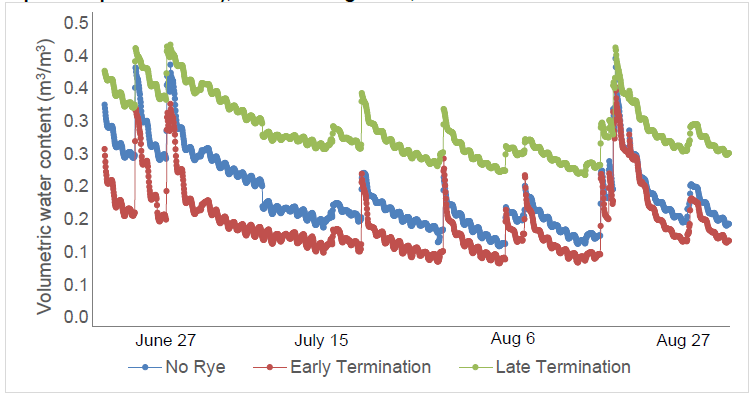
Weed effects
If you were to ask any individual who had looked at most of these sites, they would have told you that they did not observe any obvious differences in weed abundance amongst the treatments. This makes sense given that some of the on-farm sites had relatively low weed abundance and so the differences were not visually obvious. The exception was the Elora Research Station site in 2019, where there was high weed abundance and so any reductions in weed abundance were more visible.
Overall, there was a trend towards lower weed abundance at the beginning of the critical weed-free period in soybean (V1) planted into the cereal rye treatments in both 2019 and 2020 (Figures 7 & 8). Weed abundance was the lowest in the late termination treatments, which is predictable given that rye termination with glyphosate was applied later than the other treatments (Figure 9). The same trend was observed at the Wroxeter, Johnston site in 2020 (Figure 10). It should be noted, however, that weed abundance was high enough in all treatments to negatively affect yield if not controlled. Cereal rye is not going to replace other methods of weed control but can be a tool to improve the performance of other weed control methods simply because they don’t have to control as many weeds.
Figure 6. Soil temperature at 2-inch depth in early and late termination treatments at the Elora Research Station (mean of four replicates per treatment), June 21-July 21, 2019
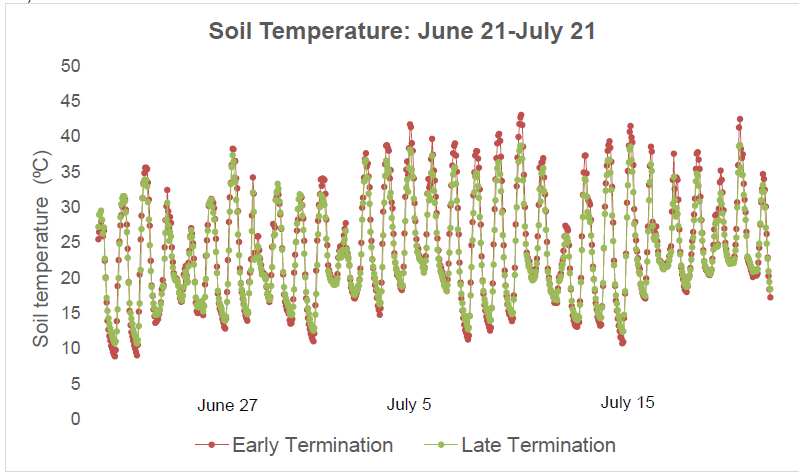
Figure 7. Weed abundance at the Elora 2019 site in the “no cereal rye” control (left), the early termination plot (centre) and the late termination plot (right).

Figure 8. Weed abundance at the Wroxeter, Johnston 2020 site in the “no cereal rye” control (left), the early termination plot (centre) and the late termination plot (right).

Figure 9. Average weed abundance (plants/m2) across 5 Ontario locations at the beginning of the critical weed-free period of soybean (V1) in 2019.
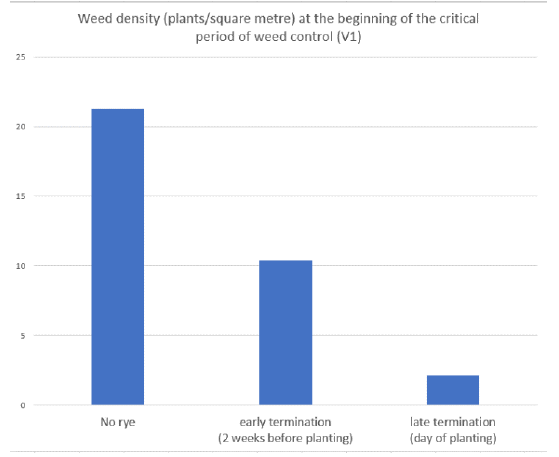
Figure 10. Average weed abundance (plants/m2) across at the Wroxeter, Johnston site at the beginning of the critical weed-free period of soybean (V1) in 2020.
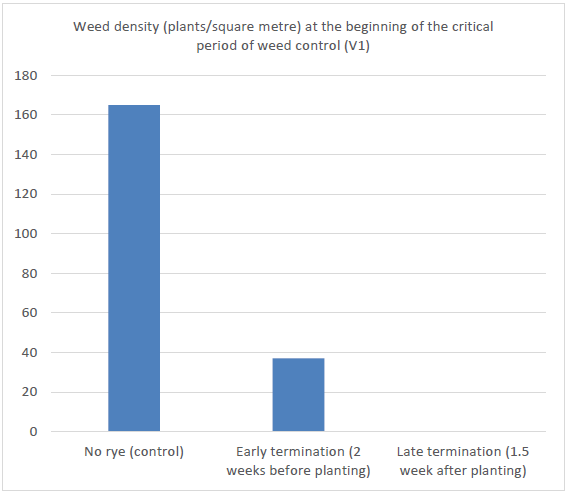
Yield results
Soybean yield varied from a low of 33.4 to a high of 69.5 bushels/acre across all sites (Table 6). There was a statistically significant difference in yield between early and late termination at only one out of ten sites. At the Elora 2019 site, the yield difference was almost certainly due to only a single herbicide application in the Late Termination treatment, as well as plant stand damage caused by roller crimper activity in wet conditions. Otherwise, yields between early and late terminated rye treatments did not differ.
Table 6. Summarized yield results from all sites. Statistically significant differences in yield amongst treatments at each site are shown by different letters.
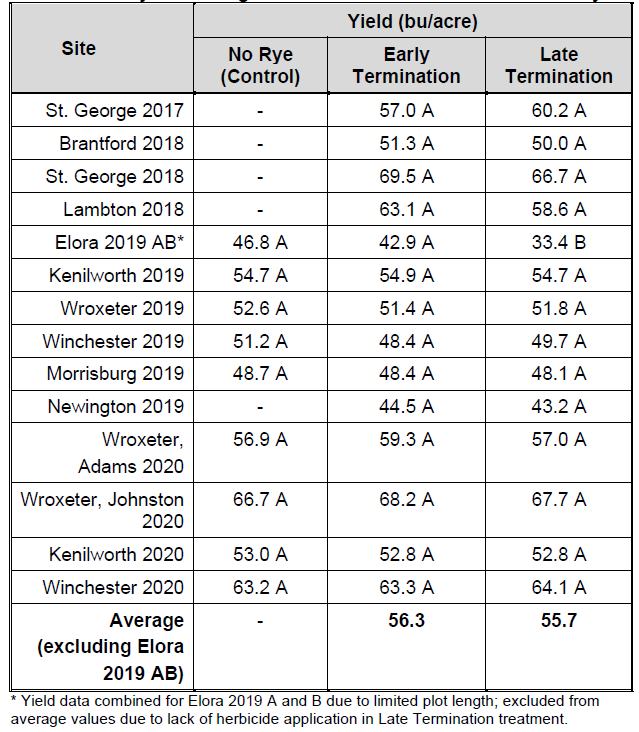
Delaying termination post-planting
At the Winchester site, different yield results were observed in the two seasons (Table 7). In the wet spring of 2019, there was no difference in soybeans yield across any of the rye seeding or termination timing treatments. In the dry spring of 2020, however, soybean yields were significantly reduced in the two latest termination timings where rye was seeded early. A similar trend was observed at the Morrisburg site in 2020 (Table 8; no statistics reported due to insufficient replication). While soybean shading in treatments T3 and T4 is believed to have negatively impacted soybean development at Winchester, it is likely that excess moisture uptake by rye was the largest factor at both Eastern Ontario sites in 2020.
Table 7. Summarized yield data for Winchester 2019 and 2020 plots
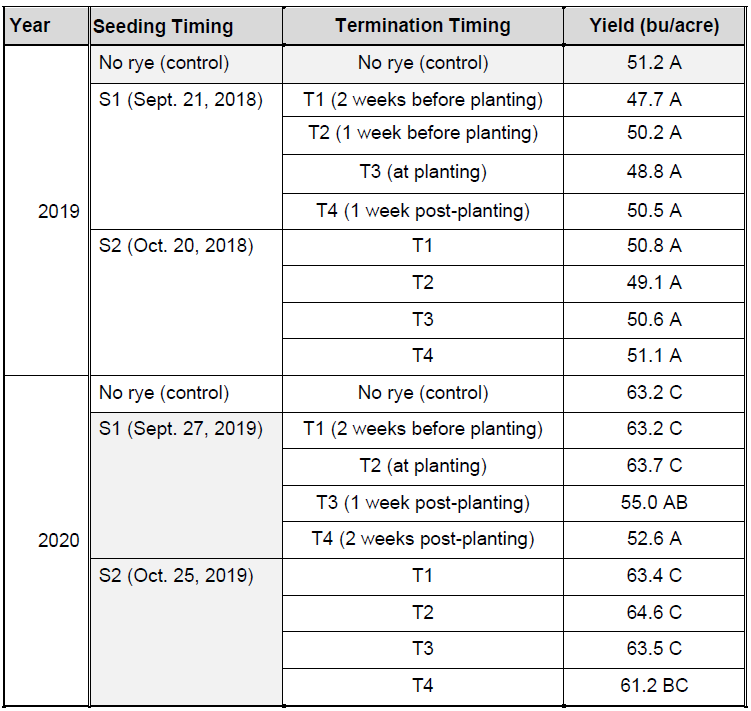
Table 8. Summarized yield data for Morrisburg 2020 plot

Summary
- Planting soybeans green into rye did not negatively impact yield relative to early termination; however, delaying termination until two weeks after planting did hurt yields in 2020
- Delaying termination until soybean planting increased rye biomass by 2.5 times, resulting in a greater contribution to soil organic matter and soil structure improvement
- Planting green increased the amount of nitrogen scavenged by 55%. This can help protect nitrogen from losses.
- Delaying termination of rye resulted in lower weed abundance in both 2019 and 2020. Late-terminated rye can be a tool to assist other forms of weed control.
Making sense of the numbers
Despite the benefits, delaying termination of rye until soybean planting carries some risk. The following strategies can be used to minimize risk:
- When planting green into rye, use a minimum seeding rate of 160,000 seeds/acre minimum to ensure an adequate stand
- Pay close attention to moisture at seeding depth, since rye can create drier soil conditions
- When seeding into thick rye:
- Ensure good slot closure
- Consider the impact of delayed soybean maturity on harvest timing, especially if you plan to seed winter wheat after soybeans
- Be flexible – if conditions turn dry in May, consider early termination
While letting rye grow for an additional week or two after planting can further improve soil health and weed suppression benefits, it carries heightened risk to soybean yield. This is especially the case for thicker, early-seeded rye and under dry spring conditions.
Putting it together
There’s no doubt that allowing an extra couple weeks of growth maximizes the soil benefits of a rye cover crop: more biomass, more time with active roots and a lasting mulch. There are also weed management benefits.
If you’re new to rye as a cover crop, gain confidence by terminating it a couple of weeks before planting soybeans in the spring. If you’re more experienced, leave a couple strips to be sprayed after soybean planting and see how it works on your farm. Have a goal in mind – is it weed management, building organic matter or overall soil health? And finally, be flexible and adapt your plans according to weather conditions.
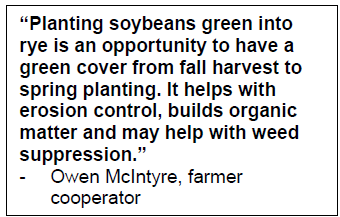
Next Steps
This is the final report for this OSCIA Tier 2 project.
Acknowledgements
This project was supported by OSCIA Tier 1 (2018) and Tier 2 project funding. Donations of cereal rye seed were generously made by Cribit Seeds and Centre de Criblage de Marc Bercier. Thank you to Mike Cowbrough and Sebastian Belliard (OMAFRA) for their collaboration and to Ian McDonald (OMAFRA) for support with statistical analysis. Finally, thank you to all the farmer cooperators who have participated over the past four years.
Project Contacts:
For more information, contact Jake Munroe, Soil Management Specialist (Field Crops), OMAFRA at: jake.munroe@ontario.ca or 519 301 0548.
